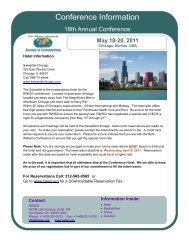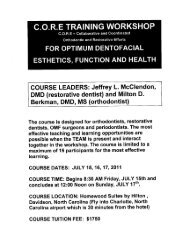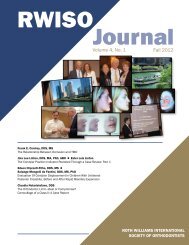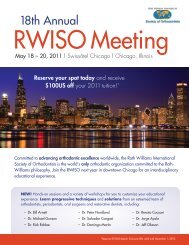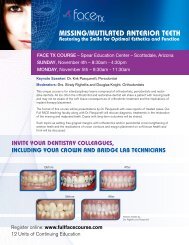2010 RWISO Journal - Roth Williams International Society of ...
2010 RWISO Journal - Roth Williams International Society of ...
2010 RWISO Journal - Roth Williams International Society of ...
Create successful ePaper yourself
Turn your PDF publications into a flip-book with our unique Google optimized e-Paper software.
The Effect <strong>of</strong> Tooth Wear on Postorthodontic Pain Patients: Part 2<br />
Jina Lee Linton, DDS, MA, PhD, ABO ■ Woneuk Jung, DDS<br />
Jin a Le e Li n T o n , ddS, ma, Phd, abo<br />
jinalinton@hotmail.com<br />
■ Graduated from Yonsei University<br />
(DDS, PhD), 1986<br />
■ Graduated from Columbia University,<br />
SDOS, 1988<br />
■ Graduated from Columbia University<br />
Orthodontic Department (MA), 1991<br />
■ Private Practice in Seoul, Korea,<br />
1991–present<br />
Wo n e u K Ju n G , ddS<br />
■ Graduated from Dan Kook<br />
University, 1991<br />
■ Private practice in Seoul, Korea,<br />
1991–present<br />
Introduction<br />
Tooth attrition is classified as tooth disease under the Inter-<br />
national Classification <strong>of</strong> Diseases, published by the World<br />
Health Organization. According to Jablonski, tooth attrition<br />
takes place when tooth-to-tooth contact, as in mastication,<br />
occurs on the occlusal, incisal, and proximal surfaces. 1 It is<br />
differentiated from tooth abrasion (the pathologic wearing<br />
away <strong>of</strong> the tooth substance by friction, as brushing, bruxism,<br />
clenching, and other mechanical causes) and from tooth<br />
erosion (the loss <strong>of</strong> substance caused by chemical action<br />
without bacterial action).<br />
In reality, the wear may be related to a combination <strong>of</strong><br />
factors including attrition, abrasion, and erosion; that is,<br />
physical-mechanical and chemical effects can have an impact<br />
on the loss <strong>of</strong> physiologic and habitual tooth surface morphology.<br />
2 Grippo et al state that three physical and chemical<br />
mechanisms are involved in the etiology <strong>of</strong> tooth surface lesions.<br />
These mechanisms are stress, corrosion, and friction.<br />
The various types <strong>of</strong> dental lesion are caused by these mechanisms<br />
acting either alone or in combination. Friction, including<br />
abrasion (which is exogenous) and attrition (which is<br />
endogenous), leads to the dental manifestation <strong>of</strong> wear. Corrosion<br />
leads to the dental manifestation <strong>of</strong> chemical or elec-<br />
Summary<br />
Malocclusion and occlusal interference in excursive movement is the major<br />
cause <strong>of</strong> pathologic tooth wear. Tooth wear starts with shortening <strong>of</strong> the anterior<br />
teeth. As interference in mandibular movement increases, the posterior<br />
teeth gradually become more flat. Recognizing tooth wear before and after<br />
orthodontic treatment is important for retention <strong>of</strong> the treated result and for<br />
ensuring functional occlusion. For this reason, orthodontic treatment should<br />
be detailed and completed with restorative rehabilitation <strong>of</strong> the lost tooth<br />
material.<br />
trochemical degradation. Stress, which results in compression,<br />
flexure, and tension, leads to the dental manifestation<br />
<strong>of</strong> micr<strong>of</strong>racture. 3<br />
Loss and excessive wear <strong>of</strong> hard dental tissues is a permanent<br />
problem <strong>of</strong> the dentition, especially in the modern<br />
man; it is found in almost all age groups. Tooth wear is an<br />
inherent part <strong>of</strong> the aging process; it occurs continuously but<br />
slowly throughout life. In some individuals, tooth wear occurs<br />
more rapidly than in others, leading to severe morphologic,<br />
functional, and vital damage to the teeth, which cannot<br />
be considered normal. 4 Hand et al found that in a sample <strong>of</strong><br />
520 adults, 84.2% had enamel attrition, 72.9% had dentin<br />
attrition, and 4.2% had severe attrition. 5 In cases <strong>of</strong> severe<br />
attrition, Sivasithamparam et al found that 11.6% <strong>of</strong> 448<br />
adult patients had either near-pulpal exposures or frank pulpal<br />
exposures. 6<br />
Schneider and Peterson found that 15% <strong>of</strong> children<br />
demonstrate tooth wear due to bruxism. 7 Most <strong>of</strong> the prevalence<br />
studies in Europe and North America indicate that the<br />
prevalence <strong>of</strong> wear on enamel in children is common (up to<br />
60% involvement), while the prevalence <strong>of</strong> exposed dentin<br />
varies from 2% to 10%. 8,9<br />
<strong>RWISO</strong> <strong>Journal</strong> | September <strong>2010</strong><br />
57



